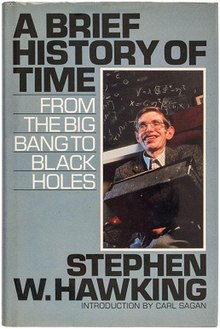A Brief History of Time
 |
|
| Author | Stephen Hawking |
|---|---|
| Country | United Kingdom |
| Language | English |
| Subject | Cosmology |
| Published | 1988 (Bantam Dell Publishing Group) |
| Media type | Print (Hardcover and Paperback) |
| Pages | 256 |
| ISBN | |
| OCLC | 39256652 |
| 523.1 21 | |
| LC Class | QB981 .H377 1998 |
| Followed by | Black Holes and Baby Universes and Other Essays |
A Brief History of Time: From the Big Bang to Black Holes is a popular-science book on cosmology (the study of the universe) by British physicist Stephen Hawking. It was first published in 1988. Hawking wrote the book for nonspecialist readers with no prior knowledge of scientific theories.
In A Brief History of Time, Hawking writes in non-technical terms about the structure, origin, development and eventual fate of the universe, which is the object of study of astronomy and modern physics. He talks about basic concepts like space and time, basic building blocks that make up the universe (such as quarks) and the fundamental forces that govern it (such as gravity). He writes about cosmological phenomena such as the Big Bang and the black holes. He discusses two major theories, general relativity and quantum mechanics, that modern scientists use to describe the universe. Finally, he talks about the search for a unifying theory that describes everything in the universe in a coherent manner.
The book became a bestseller and sold more than 10 million copies in 20 years. It was also on the London Sunday Times bestseller list for more than four years and was translated into 35 languages by 2001.
Early in 1983, Hawking first approached Simon Mitton, the editor in charge of astronomy books at Cambridge University Press, with his ideas for a popular book on cosmology. Mitton was doubtful about all the equations in the draft manuscript, which he felt would put off the buyers in airport bookshops that Hawking wished to reach. With some difficulty, he persuaded Hawking to drop all but one equation. The author himself notes in the book's acknowledgements that he was warned that for every equation in the book, the readership would be halved, hence it includes only a single equation: E = mc2. The book does employ a number of complex models, diagrams, and other illustrations to detail some of the concepts it explores.
...
Wikipedia
